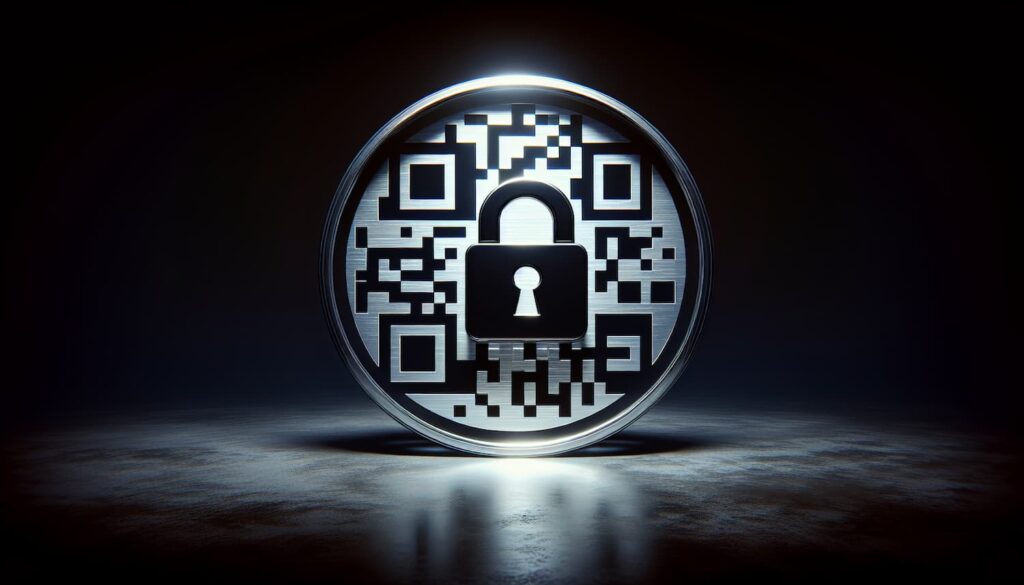
Have you ever scanned a QR code and wondered if it’s safe? With quishing—fraudulent use of QR codes—lurking online, it’s wise to be cautious.
In this guide, you will learn how to spot and stop quishing scams before they compromise your privacy and security.
Table of Contents
- Understanding Quishing: The Basics
- The Anatomy of a Quishing Attack
- Quishing vs. Smishing and Vishing: Comparing Social Engineering Techniques
- Dangers of Falling for Quishing Scams
- Strategies to Detect and Prevent Quishing Attacks
- Case Studies: Real-Life Quishing Incidents
- Best Practices for Safe QR Code Usage
- FAQs
- Wrap-Up
Understanding Quishing: The Basics
Quishing, short for ‘quick response code phishing’, is a term that arose from the increased use of QR codes, particularly during the COVID-19 pandemic.
Cybercriminals began exploiting the QR code technology to conduct phishing scams, leading to the coining of the term ‘quishing’. This deceptive practice involves tricking individuals into scanning a QR code that leads them to fraudulent activities, such as revealing sensitive information or downloading malware.
Quishing attacks can take various forms. They can:
- Direct victims to malicious websites that automatically download malware, ranging from spyware to ransomware
- Lead to the creation of payments or social media following
- Send pre-written emails from the victim’s account, leading to impersonation and further attacks.
The universal adoption of QR codes across different sectors presents new opportunities for cybercriminals to exploit them for quishing attacks, making quishing a growing cybersecurity threat.
Also see: Beware: Why You Should not Scan Any Random QR Code
The Anatomy of a Quishing Attack

In a quishing attack, the cybercriminal crafts a malicious QR code. Upon being scanned, this code directs victims to a malicious website designed to mimic trusted services and prompt for sensitive information.
These counterfeit websites often appear legitimate, tricking the user into revealing their personal information without second thought.
Malicious QR codes, including fake QR codes, used in quishing attacks can be embedded in phishing emails, luring users into participating in bogus surveys or forms. These forms often offer non-existent rewards to entice personal detail disclosure.
In some cases, scanning a quishing QR code can lead to actions like opening payment sites or sending pre-written emails from the victim’s account, aiding attackers in impersonation and further targeting.
QR phishing, as a form of quishing, also involves urgent or emotional language and poor grammar, common clues in traditional phishing scams, accompanying QR codes in QR code scams. By understanding the tactics used in QR code phishing campaigns, users can better protect themselves from falling victim to these malicious activities.
Also see: What Is a QR Code and How You Can Create One
Quishing vs. Smishing and Vishing: Comparing Social Engineering Techniques
Quishing, smishing, and vishing are all forms of social engineering attacks, with the major difference being in their delivery mechanisms. While quishing involves the misuse of QR codes, smishing leverages SMS or messaging apps, and vishing uses voice calls.
Smishing attacks often employ urgent language and malicious links that lead to fake websites designed to steal login credentials. Vishing, on the other hand, involves attackers using voice calls to personally interact with victims, often posing as trusted entities to extract sensitive information like credit card or social security numbers.
Both smishing and vishing commonly utilize an urgent tone to create a sense of immediacy, pressuring victims to act quickly and without scrutiny.
Dangers of Falling for Quishing Scams

Succumbing to quishing scams can lead to a range of serious repercussions. Unauthorized access by attackers into victims’ financial accounts frequently results in monetary loss, with phishing attacks responsible for billions of dollars in organizational losses annually.
Quishing attacks may also trigger operational interruptions including system downtime, reduced productivity, and the suspension of online services.
These disruptions can damage an organization’s reputation, erode consumer confidence, and potentially cause a decline in stock values.
Exploiting QR codes allows these scams to circumvent standard security measures, posing threats such as data breaches that expose sensitive information like user credentials or facilitating malware infections.
Also see: Use a WiFi QR Code Generator to Improve Your Customer Service
Strategies to Detect and Prevent Quishing Attacks

Adopting a multi-pronged defense strategy is a must in the fight against the escalating threat of quishing. This involves a combination of employee training and awareness, technological solutions, and robust policies and procedures.
Together, these measures can provide a comprehensive defense strategy that minimizes the risk of falling victim to quishing attacks.
Employee Training and Awareness
Regular employee training and awareness can cultivate human vigilance, one of the strongest defenses against quishing attacks.
Employees should be educated on the risks associated with scanning QR codes, teaching them how to detect suspicious emails and the proper actions to take without compromising sensitive information.
Conducting simulated quishing attacks can prove highly beneficial, as it allows organizations to assess employee response and the effectiveness of security protocols. This hands-on approach facilitates improved defense strategies and quick response to threats.
Also, implementing mentoring software can enhance employee training programs by providing personalized guidance and support to help them navigate cybersecurity risks effectively.
Furthermore, fostering a supportive cybersecurity culture where employees are encouraged to report phishing incidents leverages human vigilance as an early warning system and underscores the recognition of collective defense accomplishments.
Technological Solutions
Technological solutions are another significant factor in defending against quishing, alongside human vigilance.
AI-based detection systems can evaluate additional signals like sender information, content, and image analysis, which traditional email filters may not effectively detect. These systems serve as a crucial tool in identifying quishing attempts, making AI readiness essential for maximizing their effectiveness in your security strategy.
Implementing technologies for authentication and verifying sender domains, such as DMARC, MFA, and SSO, can significantly bolster defenses against quishing.
Additionally, antivirus and cloud email security solutions can block or quarantine suspicious emails, with integrated smart algorithms analyzing content and context for additional protection.
Real-time analysis and cloud-based protection services further aid in the immediate identification and resolution of quishing attacks, supporting a proactive and effective incident response.
Policy and Procedures
An organization’s defense against quishing is fundamentally supported by its policies and procedures. Organizations should develop policies that ensure QR codes are strategically placed in easily accessible locations, considering safety, visibility from different angles, and availability of mobile network or Wi-Fi.
Moreover, QR codes in digital settings like websites should be meticulously optimized for a user-friendly experience, helping users transition smoothly from desktop to mobile device scanning via a QR code.
Enhancing customer trust and engagement with QR codes can be achieved by incorporating brand elements such as logos and colors, with a direct call to action and a compelling explanation of their value. Utilizing a dynamic QR code can further improve this experience.
Policies should advocate for the use of UTM parameters for analytics tracking and personalization in QR code campaigns to gauge their effectiveness and customize the customer experience.
Case Studies: Real-Life Quishing Incidents
Examining real-life quishing incidents can provide a clearer picture of the potential severity and impact of these scams.
For instance, tech giants Facebook and Google were defrauded of $100 million through fake invoices by an impostor of their vendor Quanta. Similarly, Crelan Bank in Belgium experienced a $75.8 million loss after a business email compromise involving an impersonator of a high-level executive.
In another case, Austrian company FACC sent $61 million to a phisher who pretended to be the CEO, causing substantial financial damage. Ubiquiti Networks suffered a $46.7 million financial loss due to a BEC scam, where an attacker impersonated company executives.
And Upsher-Smith Laboratories was tricked into making multiple wire transfers totaling over $39 million, due to a scam involving a fake lawyer impersonating the CEO.
Best Practices for Safe QR Code Usage
Following best practices for safe QR code usage is crucial in protecting against quishing attacks. This involves a combination of personal vigilance, secure QR code generation, and regular security audits and updates.
These comprehensive measures can minimize the risk of falling victim to quishing scams.
Personal Vigilance
In terms of safe QR code usage, personal vigilance is of utmost importance. Before scanning a QR code, it’s crucial to pause and consider the source to avoid falling victim to quishing attacks.
Also, always inspect the physical appearance of QR codes for any signs of tampering, such as a sticker over the original code.
Using a dedicated QR code scanner app with additional security features can provide an extra layer of protection against fraudulent QR codes.
Before you scan QR codes, verify the URL and sender’s legitimacy, hover over the code to check it, and watch out for suspicious domains or confirmation prompts to ensure safety.
Secure QR Code Generation
Another key aspect of safe QR code usage is the secure generation of QR codes. Dynamic QR codes, which allow for the destination URL to be changed post-creation, aid in marketing campaigns and content updates without needing to generate a new QR code.
However, it’s important to note that these dynamic codes can be exploited by scammers who may alter the intended destination to redirect users to malicious websites.
Customizing QR codes with distinctive branding elements, such as embedded logos, can help mitigate the risk of fraudulent copies. Using consistent branding features like specific colors and custom borders in QR code design enhances recognition, making it harder for scammers to create convincing duplicates.
All this you can achieve with our QR code generator, which offers unique features that will help you avoid quishing.
Regular Security Audits and Updates
It is crucial to frequently perform security audits and apply updates as a defense mechanism against quishing attacks. These periodic evaluations are essential in maintaining the security of QR code systems by identifying and rectifying any weaknesses promptly.
Updating your device’s software regularly mitigates the risks associated with potential exploits that can arise from scanning QR codes.
Verifying SSL/TLS certificates on websites connected to QR codes helps in safeguarding users from being navigated towards harmful webpages. Such thorough strategies ensure that all possible areas of susceptibility are considered, offering an all-encompassing approach for secure utilization of QR codes.
FAQs
What is an example of quishing in social engineering?
An example of quishing in social engineering is when attackers use QR codes as plain images in emails to bypass filters and deceive victims into falling for their tactics.
This can lead to compromised security and potential data breaches.
Is quishing the new phishing?
Recent research from Perception Point has revealed that between August and September 2023, there was an alarming surge in quishing attacks—specifically a 427% rise—which signals an escalating trend in this particular type of cyber threat.
What is quishing?
Phishing attacks that utilize QR codes to lure individuals into accessing a harmful website or downloading a document infected with malware are known as “quishing.” This form of cybersecurity menace involves attackers employing QR codes as conduits to direct unsuspecting users towards dangerous digital material.
How does a quishing attack work?
During a quishing attack, perpetrators employ fraudulent QR codes to steer individuals toward counterfeit websites that resemble reputable platforms in order to harvest confidential data.
Exercise vigilance while scanning QR codes originating from sources that have not been verified as trustworthy.
What are some strategies to detect and prevent quishing attacks?
It’s essential to employ a mix of workforce education, technology-based defenses, and strong protocols for the detection and thwarting of quishing attacks.
Consistent awareness programs and instruction are key in enabling staff members to recognize and alert authorities about possible quishing threats.
Wrap-Up
In summary, quishing is a growing cybersecurity threat that exploits the convenience of QR codes to deceive individuals and organizations. Understanding its mechanics, recognizing its potential damages, and adopting a robust defense strategy are crucial in preventing these scams.
By fostering employee awareness, employing technological solutions, establishing robust policies, and adhering to safe QR code usage practices, we can minimize the risks and safeguard our digital environment. Let’s stay informed, vigilant, and proactive in our fight against quishing.
